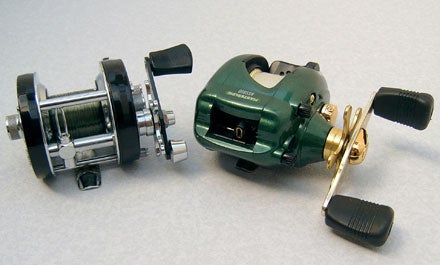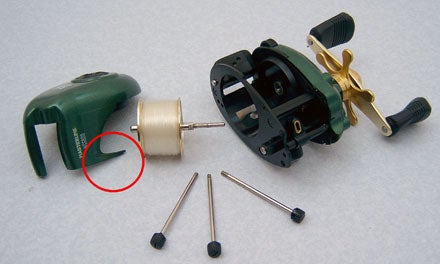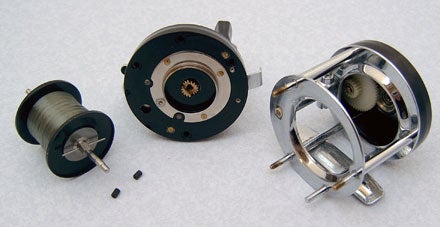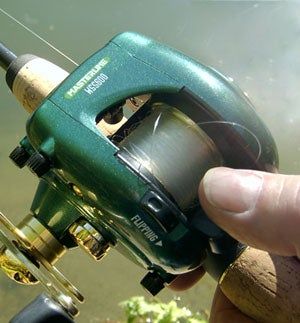| KEVIN PERKINS | |
|
Ancient and Modern Revisited – Reel ReviewsThis is perhaps an indulgence, but my first attempt at an old vs new article was lacking in detail, particularly when it came to direct comparisons between the items of tackle that were being used. So it’s on with the critical head, and below is my personal opinion as to how the small multipliers faired on the trip.
Masterline WSS600Old fashioned brake blocks and spindle friction vs. the power of magnetism hmm….. Having watched John Wilson, Rex Hunt et al effortlessly flicking out lures with their baitcasting outfits, the move onto the technologically superior Masterline should have been relatively painless. The reel certainly looks modern, but in a retro, almost Dan Dare ray-gun sort of way. Access to the line guide aperture on the level wind is restricted, to say the least, and unless you have some sort of threading device to hand it is often easier to take the side plates off to enable you to thread the line up. Care is needed when taking out the retaining screws, as they are not held captive in the housing, and they can, and will, drop out if you aren’t careful. And as highlighted in the picture, the plastic side plate looks fragile, to say the least. Spool release for casting is affected by pushing down on the thumb bar and engaging the free pool whilst trying to hold the spool at the same time. It is a skill that takes a little while to master, and casts made when you have failed to engage the thumb bar properly tend to come up a bit short.
There is the option of engaging the quaintly named ‘Flipping button’, which means that the spool is released when you press on the thumb bar, but the free spool is not locked. This is a far more entertaining way of casting as you have to push down on the button and hold it down as the rod is moving away from you as you cast. It takes a lot of practice to get the timings just right, and any slight pressure release of the thumb bar immediately curtails the cast. The magnetic spool control does tame over runs, although adjustment to the level of braking appears coarse. For some reason the adjustment dial slips during use; this may well be caused by my ham-fisted casting attempts, but if it is that easy to dislodge the settings, perhaps a stronger detent is needed on the dial. On a couple of occasions loose loops of line appeared on the spool, not a bird’s nest proper, but the loops were able to get between the spool and housing, meaning that the reel had to be broken down to clear the loops. The fact that there is enough clearance between the spool and housing for this to happen would either indicate a flaw in the design, or that manufacturing tolerances were too wide. Retrieving was fairly trouble free, and the gear ratio is high enough to keep most lures away from snags without having to wind so fast that your hand becomes a blur, although considering that these bait-casting reels are rarely going to be casting more than 20-30 yards, the need for a level wind is perhaps open to question. Its removal will probably increase casting distance, and with those relatively small amounts of line out, bunching on the spool during retrieval shouldn’t be a problem ABU5001cAn old reel (30+ years) and therefore old design, but if it ain’t broke…. A solidly constructed little multiplier, albeit in the traditional mode. It has a wider frame, compared to the Masterline, which means better access to the spool, with the line guide being a simple ‘bent wire’ affair. A small button on top of the side plate engages the free spool with a positive click, leaving you in no doubt that it has done its job. Opposite to the handle a knurled knob on the side plate adjusts the spindle end float and acts as a form of clutch.Conventional wisdom says you should depress the spool release and adjust this knob until the weight of whatever lure you are using is just beginning to pull line from the spool. That will do to start with, but as you get bolder, and your confidence grows, you can be sure that clutch will get loosened off…
Spool over-run is mechanically controlled by tiny brake blocks, which reside in a housing under the handle. During casting they are centrifugally spun out to the end of their spindles and apply a braking force through friction against the housing. The bad news is that that you can have many permutations of these blocks, 2 large, 2 medium, 2 small or 1 large and 1 medium, 1 medium and 1 small, etc, etc. Or you can run with just one block instead of pairs, if you are very brave/stupid you can take them out completely. The best thing to do is not worry about them at all, put a couple of medium size blocks in before you go fishing and use the spindle float dial for any adjustment on the bankside. During the session in question, despite changing lure sizes and weights through the day, I made no adjustments at all, and didn’t suffer one bird’s nest.
The only other things to compare between these two reels is their weight, the Masterline’s perhaps less robust construction tipping the scales at 280 gms and the ABU at 329 gms, such a small difference is really not noticeable during fishing. The other matter where the two reels are at odds is in the operation of the clutch. In the ABU, winding the star drag anti-clockwise loosens the clutch, and is exactly how you would normally loosen anything. On the Masterline, it is a clockwise motion of the star drag that loosens the clutch. Of the two, it is the ABU action that seems more natural. In conclusion, preference boils down to traditional versus technology. The ABU is the more tactile, needing, but at least allowing, several adjustments before you get going. But for all its attempts in making life simpler through technology, the Masterline isn’t a massive leap forward in ease of operation. Perhaps this isn’t a totally fair comparison, as the ABU is/was a top end model, and the Masterline clearly aimed more at the mass-market. Both will do the job that is asked of them, but given that the ABU is thirty years old, it is engineered in such a way to make you believe it will still be going strong in another thirty years. If I am lucky enough to be around in 2037 (and still fishing) I’m not so sure I will still be using the Masterline…… The real issue (no pun intended) is that it almost certainly pays to buy the best engineered equipment that you can afford, this is certainly an area where the ‘buy cheap, buy twice’ saying holds very true. |















